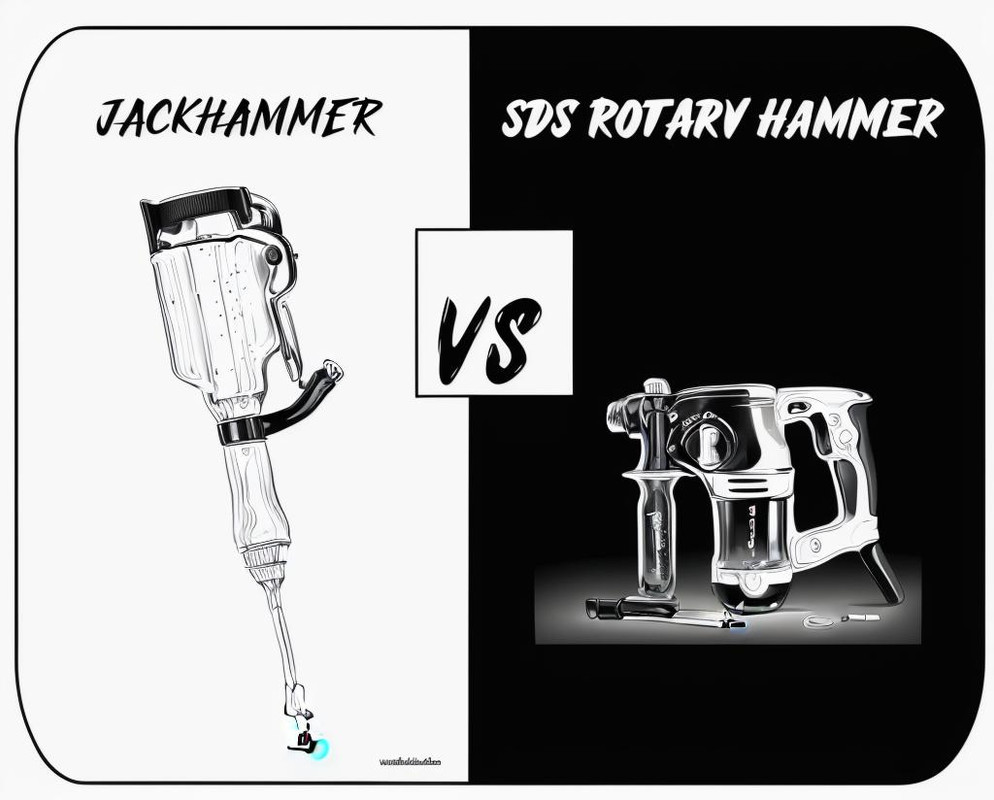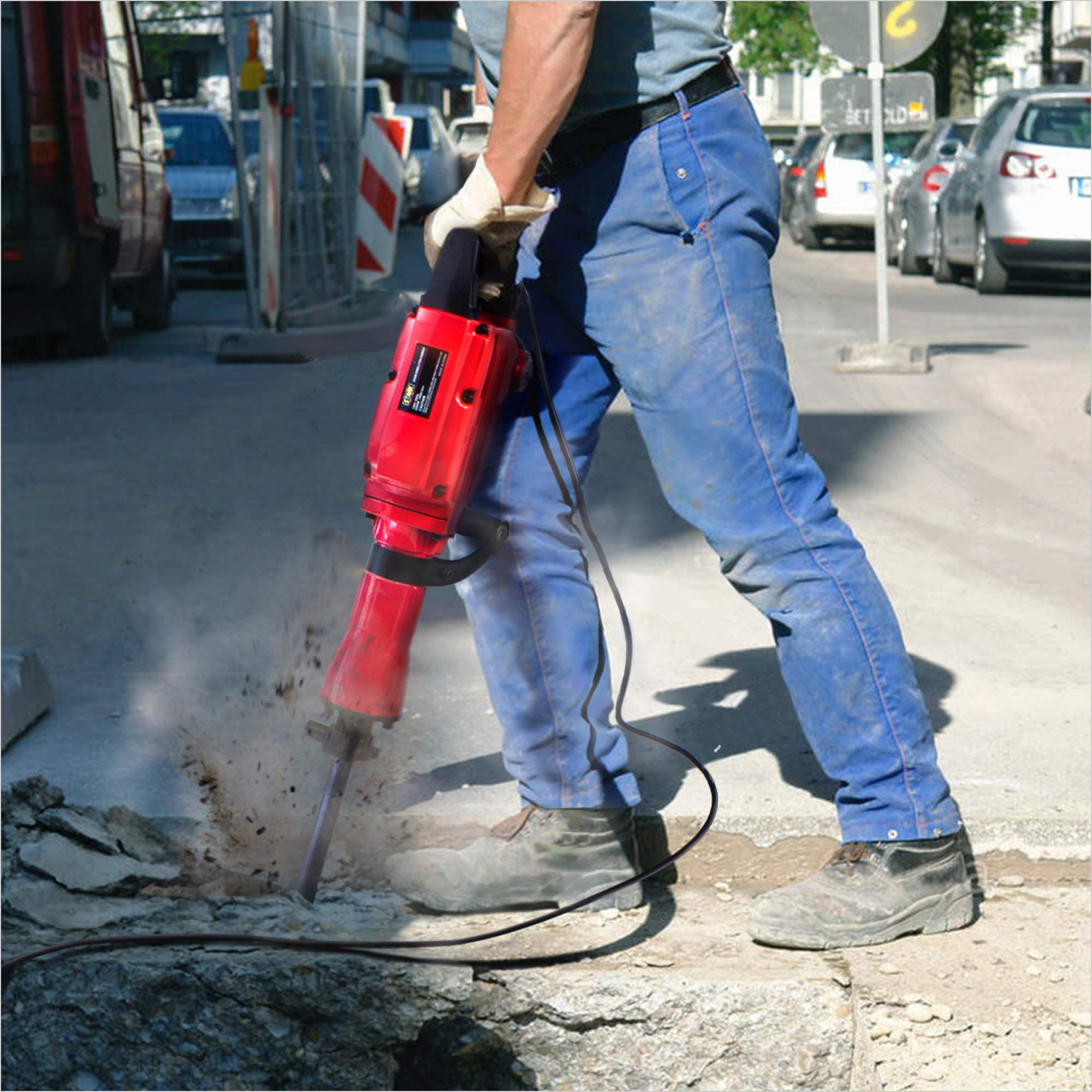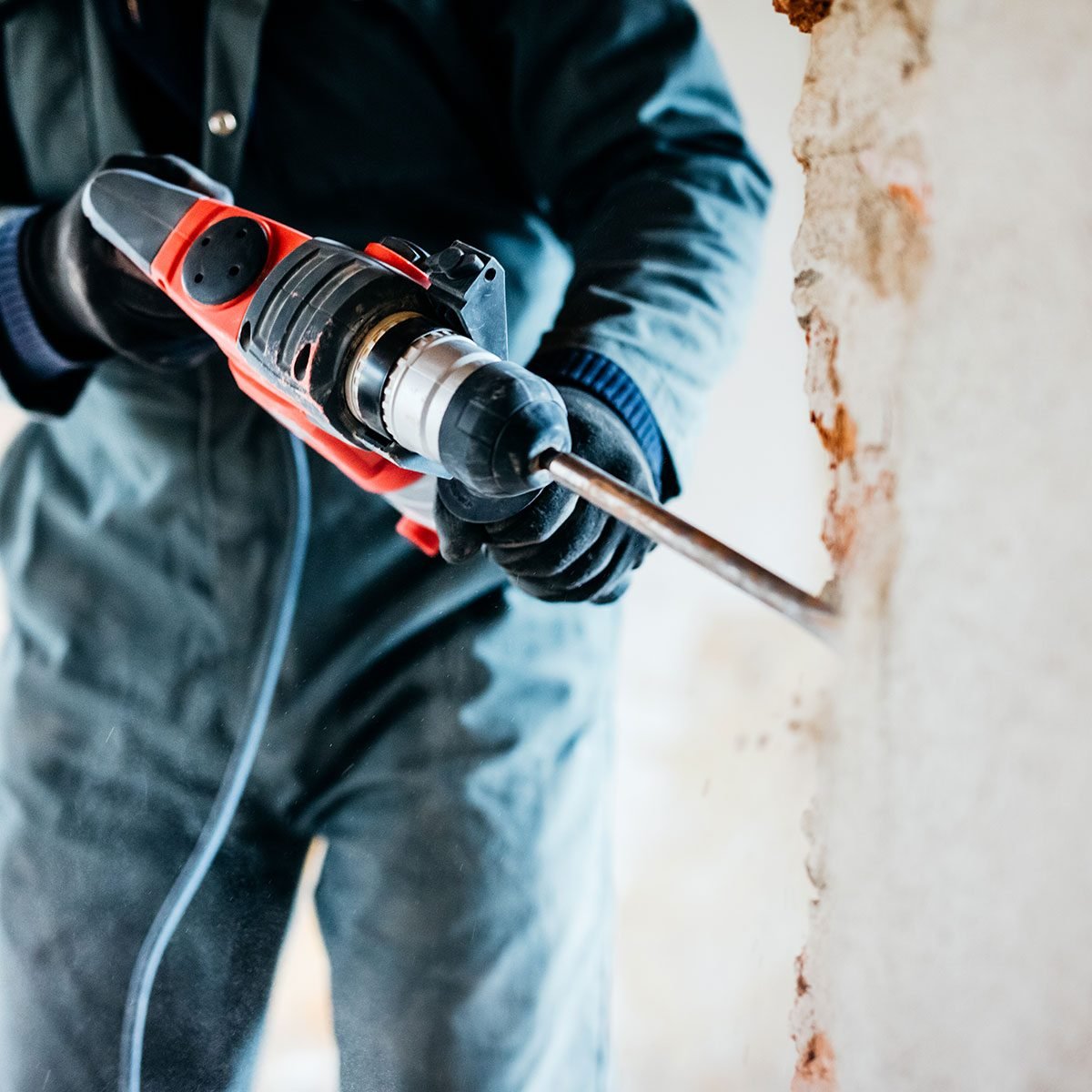Yes, you can use a hammer drill as a jackhammer, but it depends on the task. A hammer drill can handle light-duty tasks, while a jackhammer is better for heavy-duty jobs.
When faced with breaking up concrete or other tough materials, the right tool makes all the difference. Many people wonder if a hammer drill can double as a jackhammer. It’s a common question, especially for those looking to save money or space in their tool collection.
While both tools offer powerful drilling action, their purposes and capabilities vary. This blog will explore the differences between a hammer drill and a jackhammer, helping you decide which tool is best for your specific needs.

Credit: www.dingguantools.com
Article Summary
Introduction To Hammer Drills And Jackhammers
Hammer drills and jackhammers are powerful tools used in construction. Their main purpose is to break tough materials like concrete and brick. Although they seem similar, they have different uses and features. Let’s explore these tools to understand their unique functions and key differences.
Purpose And Function
Hammer drills are versatile tools often used for drilling holes in hard surfaces. They combine a hammering action with a drilling motion. This makes them perfect for tasks that need both force and precision.
Jackhammers, on the other hand, are designed for heavy-duty demolition work. They use a piston-driven hammering action to break up large, solid materials. This makes them ideal for tasks that require brute force and power.
Key Differences
| Feature | Hammer Drill | Jackhammer |
|---|---|---|
| Primary Use | Drilling holes in concrete, brick, and stone | Breaking and demolishing concrete, asphalt, and rock |
| Mechanism | Hammering and drilling combined | Hammering only |
| Portability | Generally lightweight and portable | Heavier and less portable |
| Power Source | Electric or battery-powered | Pneumatic or electric |
| Precision | High | Low |
Understanding these differences helps in choosing the right tool for the job. Hammer drills are best for tasks needing both drilling and light hammering. Jackhammers are perfect for heavy-duty demolition work.
Hammer Drill Capabilities
A hammer drill is a versatile tool. It combines the functionality of a drill and a hammer. This makes it a popular choice for many projects. But can it replace a jackhammer? Let’s explore its capabilities.
Basic Functions
A hammer drill operates in two modes. It can rotate like a regular drill. It also delivers rapid hammering blows. This helps to break through tough materials. Most hammer drills have a switch. This allows you to change between modes easily.
In drill mode, it works like any other power drill. In hammer mode, it adds a pounding action. This makes it more effective for hard surfaces. Many models also offer variable speed settings. This gives you more control over the tool.
Suitable Materials
Hammer drills are great for many materials. They can drill through concrete, brick, and stone. They can also handle wood, metal, and plastic. This makes them versatile for various tasks. They are ideal for home improvement projects.
For light demolition work, a hammer drill can be useful. It can break up small areas of concrete or tile. But it cannot match the power of a jackhammer. For larger jobs, a jackhammer is more suitable.
In summary, a hammer drill is versatile. It handles many materials well. For small jobs, it can be a good alternative to a jackhammer.
Jackhammer Capabilities
Understanding the capabilities of a jackhammer is essential. It helps you know whether a hammer drill can serve as a jackhammer. Let’s dive into the basic functions and suitable materials for jackhammer use.
Basic Functions
A jackhammer is a powerful tool. It breaks up hard surfaces like concrete and asphalt. The tool has a heavy-duty motor that delivers strong blows. Jackhammers use a chisel or pointed bit to break up materials.
Hammer drills and jackhammers share some functions. Both tools drill into hard surfaces. Yet, there are key differences. A hammer drill has a rotary function, which a jackhammer lacks. This rotary action is useful for drilling holes. Jackhammers, on the other hand, focus on breaking and chipping.
Suitable Materials
Jackhammers work best on very hard surfaces. Concrete, asphalt, and rock are common targets. The tool’s powerful blows make quick work of these tough materials. It is ideal for demolition work and large construction projects.
Hammer drills also handle hard materials, but their power is limited. They are suitable for masonry, brick, and light concrete. For heavy-duty tasks, a jackhammer is the better choice. Hammer drills are more versatile for smaller jobs, especially where precision is needed.
Here’s a quick comparison:
| Tool | Suitable Materials | Primary Function |
|---|---|---|
| Hammer Drill | Masonry, Brick, Light Concrete | Drilling with Rotary Action |
| Jackhammer | Concrete, Asphalt, Rock | Breaking and Chipping |
Each tool has its strengths. Knowing these helps you choose the right tool for the job.
Comparing Power And Performance
Comparing the power and performance of a hammer drill and a jackhammer can help you decide which tool is better for your needs. Both tools have their strengths and weaknesses. Understanding these differences will make your choice easier.
Power Output
A hammer drill is designed for drilling into tough materials. It uses a pulsing hammering action. This action helps to break up the material while the drill bit turns. The power output of a hammer drill is suitable for drilling into concrete, stone, and brick.
A jackhammer, on the other hand, is built for heavy-duty demolition. It delivers intense, rapid hammering blows. This makes it ideal for breaking up concrete, asphalt, and other hard surfaces. The power output of a jackhammer is significantly higher than that of a hammer drill. This allows it to break up large areas of material quickly.
Efficiency In Different Tasks
A hammer drill is efficient for tasks requiring precision and control. It is perfect for drilling holes for anchors, screws, and bolts. The hammer drill’s compact size makes it easy to handle. This is especially useful in tight spaces.
A jackhammer is more efficient for large-scale demolition projects. It is perfect for breaking up sidewalks, driveways, and other large concrete slabs. The jackhammer’s sheer power and force make it less suitable for delicate tasks. It is better for brute force applications.
In summary, a hammer drill excels in tasks requiring precision. A jackhammer is unmatched in tasks demanding raw power. Choosing the right tool depends on your specific needs and the nature of the job.
Safety Considerations
Using a hammer drill as a jackhammer can be risky. Understanding the safety considerations is crucial. This ensures your well-being while using these powerful tools. Let’s delve into the key safety aspects.
Proper Usage
Proper usage of a hammer drill prevents accidents. Always read the manual first. Follow instructions carefully. Use the right settings for different tasks. Never force the tool. Let the drill do the work. Incorrect usage can lead to injuries.
Check the drill for any damage before each use. Ensure all parts are in good working condition. Regular maintenance is essential. A well-maintained tool is safer and more efficient.
Protective Gear
Wearing protective gear is a must. This minimizes the risk of injury. Always wear safety goggles. They protect your eyes from flying debris. Hearing protection is also important. Hammer drills can be very loud.
Use gloves to protect your hands. They provide a better grip and prevent blisters. Sturdy footwear is essential. It protects your feet from falling objects. Wear a dust mask if working in a dusty environment.
| Protective Gear | Purpose |
|---|---|
| Safety Goggles | Protect eyes from debris |
| Hearing Protection | Shield ears from loud noise |
| Gloves | Improve grip, prevent blisters |
| Sturdy Footwear | Protect feet from heavy objects |
| Dust Mask | Filter out dust particles |
In summary, safety considerations are vital. Proper usage and protective gear are key. Stay safe while using a hammer drill as a jackhammer.

Credit: www.homedepot.com
Cost And Accessibility
Understanding the cost and accessibility of using a hammer drill as a jackhammer is crucial. This section focuses on comparing the price and availability of both tools.
Price Comparison
Both tools have different price points. A hammer drill is generally more affordable. Below is a table comparing the average prices:
| Tool | Price Range |
|---|---|
| Hammer Drill | $50 – $200 |
| Jackhammer | $200 – $1,000 |
The price of a hammer drill is significantly lower. This makes it a cost-effective choice for many users.
Availability
Availability also plays a key role. Hammer drills are easier to find. They are available in most hardware stores and online.
Jackhammers, on the other hand, are less common. They are usually found in specialized stores or rental shops.
If you need a tool quickly, a hammer drill is more accessible. This adds to its appeal for many DIY enthusiasts.
Practical Applications
A hammer drill is a versatile tool. It can handle more than just drilling. One of its surprising uses is to function as a jackhammer. This can save time and money. Let’s explore the practical applications of using a hammer drill as a jackhammer.
Residential Projects
In residential projects, a hammer drill can be a homeowner’s best friend. It can break up concrete patios, driveways, or sidewalks. This is very useful for small demolition jobs. It can also help in removing tiles in a bathroom or kitchen.
- Breaking concrete slabs: A hammer drill can break concrete slabs up to 4 inches thick.
- Removing tiles: Use a chisel bit to remove tiles quickly and efficiently.
- Small demolition jobs: Ideal for breaking up small sections of walls or floors.
Using a hammer drill in residential settings is practical. It is also cost-effective. Renting or buying a jackhammer can be expensive. A hammer drill is a great alternative for small jobs.
Commercial Projects
In commercial projects, a hammer drill can be used for light to medium demolition. It is ideal for breaking up concrete floors and walls. This can be useful in remodeling or renovation projects.
| Application | Description |
|---|---|
| Concrete Floor Removal | Breaks up concrete floors in small sections. |
| Wall Demolition | Removes sections of concrete or brick walls. |
| Pathway Construction | Prepares ground by breaking up old concrete paths. |
While a hammer drill may not replace a full-size jackhammer, it is useful for smaller tasks. It is especially useful in tight spaces. Its versatility makes it a valuable tool in many commercial projects.

Credit: www.familyhandyman.com
Making The Right Choice
Choosing the right tool for your project can save time and effort. Using a hammer drill as a jackhammer may seem convenient. However, it is crucial to consider several factors. This section will help you make the right choice.
Project Requirements
First, assess your project requirements. A hammer drill and a jackhammer serve different purposes. A hammer drill is ideal for drilling into materials like concrete, brick, or stone. It is perfect for smaller tasks such as installing anchors or drilling holes.
On the other hand, a jackhammer is designed for heavy-duty demolition work. Breaking up concrete slabs, asphalt, or large rocks requires a tool with more power. Using a hammer drill for such tasks may lead to inefficiency and tool damage.
Tool Longevity
Tool longevity is another key factor. Hammer drills are not built to endure the same level of stress as jackhammers. Consistently using a hammer drill for heavy-duty tasks can reduce its lifespan. This leads to frequent repairs or replacements.
Investing in the right tool for the job ensures better performance and durability. A jackhammer is built to withstand intense, repetitive impacts. This makes it a more suitable choice for heavy demolition work.
| Project Type | Recommended Tool |
|---|---|
| Drilling holes in concrete | Hammer Drill |
| Installing anchors in brick | Hammer Drill |
| Breaking up concrete slabs | Jackhammer |
| Demolishing asphalt | Jackhammer |
Frequently Asked Questions
Can A Hammer Drill Be Used As A Jackhammer?
A hammer drill can handle light demolition but lacks the power of a jackhammer. It’s best for small projects.
What Is The Difference Between A Hammer Drill And A Jackhammer?
A hammer drill is for drilling and light chiseling. A jackhammer is more powerful and used for heavy demolition.
Is A Hammer Drill Good For Concrete?
A hammer drill can manage small concrete tasks. For heavy-duty concrete work, use a jackhammer.
Can You Break Up Concrete With A Hammer Drill?
You can break small sections of concrete with a hammer drill. For large areas, a jackhammer is better.
Conclusion
A hammer drill can handle light demolition tasks. It’s versatile for small projects. For heavy-duty jobs, a jackhammer remains the best tool. Choose the right tool for your needs to save time. Always prioritize safety when using power tools. Understanding their limits helps you work effectively.
So, make the best choice and work smartly. Your project will thank you.